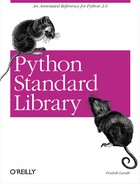(New in 2.0) The mmap module provides an interface to the operating
system’s memory mapping functions, as shown in Example 2-13. The mapped region behaves like a string object, but data is read directly from the file.
Example 2-13. Using the mmap Module
File: mmap-example-1.py import mmap import os filename = "samples/sample.txt" file = open(filename, "r+") size = os.path.getsize(filename) data = mmap.mmap(file.fileno(), size) # basics print data print len(data), size # use slicing to read from the file print repr(data[:10]), repr(data[:10]) # or use the standard file interface print repr(data.read(10)), repr(data.read(10))<mmap object at 008A2A10>302 302'We will pe' 'We will pe''We will pe' 'rhaps even'
Under Windows, the file must currently be opened for both reading and
writing (r+, or w+), or the
mmap call will fail.
Example 2-14 shows that memory mapped regions can be used instead of ordinary strings in many places, including regular expressions and many string operations.
Example 2-14. Using String Functions and Regular Expressions on a Mapped Region
File: mmap-example-2.py
import mmap
import os, string, re
def mapfile(filename):
file = open(filename, "r+")
size = os.path.getsize(filename)
return mmap.mmap(file.fileno(), size)
data = mapfile("samples/sample.txt")
# search
index = data.find("small")
print index, repr(data[index-5:index+15])
# regular expressions work too!
m = re.search("small", data)
print m.start(), m.group()
43 'only small�15�12modules '
43 small..................Content has been hidden....................
You can't read the all page of ebook, please click here login for view all page.
